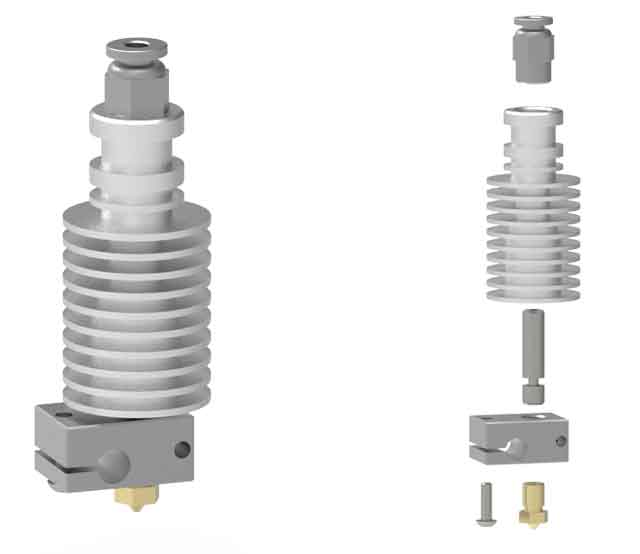We continue with the section on design for 3D printing, looking at the components of a 3D printer. This time it’s the hotend.
In the previous post, we saw the print head and its importance in the operation of an FFF 3D printer. As we saw, inside the print head is the hotend, which is the element for melting the filament and depositing it onto the piece.
At the top we have a hole through which the filament is inserted. If the printer is of Differences between direct or bowden 3D printers there will be a pressure retainer that is responsible for holding one end of the bowden tube.

The material is melted in the lower metal block in a prismatic shape. In it, a thermistor is housed in the larger hole, which is simply fixed with a screw.
It is important to maintain the appropriate temperature with the material we are depositing. Therefore, in this block also houses a thermosensor that, together with the electronics of the board, are responsible for maintaining a constant printing temperature.
The “ideal” behavior of the hotend would be to keep the filament cold until the moment it comes out, maintaining the shortest possible length of melted filament.

To do this, the main body of the hotend is formed by a heatsink with fins through which air is circulated with a fan. This element dissipates the heat generated in the block, and allows the material to arrive without melting to the outside.
The block and the heatsink are joined by a throat that has both ends threaded, and to which both elements are screwed. There are two types of throats, those with the inside with a plastic tube and those that are fully metal. In principle, throats with plastic interior are less prone to clogging, while full metal ones are required for printing high-temperature materials.
Finally, at the bottom of the hotend is located the extrusion nozzle. This element, usually made of brass, has a threaded end with which it is attached to the block.

The extrusion nozzle transmits the final dimension to the deposited filament, and therefore it is important that it is correctly and precisely machined. Nozzle thicknesses range from 0.1mm to 1.6mm, with the most common being from 0.4 to 0.8mm.
Of course, there are many types of hotends available. Some of the most popular are the E3D V5 and V6, and their Chinese clones (of not such good quality). Although it is not the only type of hotend.
So far, the post on the hotend of an FFF printer and its operation. As we can see, it is one of the most important elements of a 3D printer. In the next post we will see the extruder
